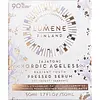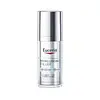Lumene Ajaton Nordic Ageless Radiant Youth Pressed Serum Versus Eucerin Hyaluron-Filler Epicelline Serum
What's inside
What's inside
 Key Ingredients
Key Ingredients

 Benefits
Benefits

 Concerns
Concerns

 Ingredients Side-by-side
Ingredients Side-by-side

Water
Skin ConditioningGlycerin
HumectantPropanediol
SolventNiacinamide
SmoothingDicaprylyl Carbonate
EmollientOctyldodecyl Myristate
EmollientBetaine
HumectantCanola Oil
EmollientHydrogenated Vegetable Oil
EmollientSqualane
EmollientButylene Glycol
HumectantC12-16 Alcohols
EmollientAvena Sativa Kernel Oil
Skin ConditioningVaccinium Vitis-Idaea Fruit Extract
AntioxidantVaccinium Vitis-Idaea Seed Oil
AntioxidantRubus Chamaemorus Fruit Extract
AntioxidantCalluna Vulgaris Flower Extract
Skin ConditioningPhenoxyethanol
PreservativePolyurethane-39
Hydroxyethyl Acrylate/Sodium Acryloyldimethyl Taurate Copolymer
Emulsion StabilisingCetearyl Alcohol
EmollientHydrogenated Lecithin
EmulsifyingPalmitic Acid
EmollientTocopherol
AntioxidantPolyisobutene
Dimethicone
EmollientHelianthus Annuus Seed Oil
EmollientSodium Lauroyl Lactylate
EmulsifyingEthylhexylglycerin
Skin ConditioningDisodium EDTA
Pentylene Glycol
Skin ConditioningPEG-7 Trimethylolpropane Coconut Ether
EmulsifyingAdenosine
Skin ConditioningHydrolyzed Hyaluronic Acid
HumectantCitric Acid
BufferingXanthan Gum
EmulsifyingCeramide NP
Skin ConditioningGluconolactone
Skin ConditioningCeramide AP
Skin ConditioningPhytosphingosine
Skin ConditioningCholesterol
EmollientSodium Benzoate
MaskingCarbomer
Emulsion StabilisingCaprylyl Glycol
EmollientPotassium Sorbate
PreservativeN-Prolyl Palmitoyl Tripeptide-56 Acetate
Skin ConditioningRosmarinus Officinalis Leaf Extract
AntimicrobialCalcium Gluconate
HumectantCeramide EOP
Skin ConditioningParfum
MaskingIron Oxides
Water, Glycerin, Propanediol, Niacinamide, Dicaprylyl Carbonate, Octyldodecyl Myristate, Betaine, Canola Oil, Hydrogenated Vegetable Oil, Squalane, Butylene Glycol, C12-16 Alcohols, Avena Sativa Kernel Oil, Vaccinium Vitis-Idaea Fruit Extract, Vaccinium Vitis-Idaea Seed Oil, Rubus Chamaemorus Fruit Extract, Calluna Vulgaris Flower Extract, Phenoxyethanol, Polyurethane-39, Hydroxyethyl Acrylate/Sodium Acryloyldimethyl Taurate Copolymer, Cetearyl Alcohol, Hydrogenated Lecithin, Palmitic Acid, Tocopherol, Polyisobutene, Dimethicone, Helianthus Annuus Seed Oil, Sodium Lauroyl Lactylate, Ethylhexylglycerin, Disodium EDTA, Pentylene Glycol, PEG-7 Trimethylolpropane Coconut Ether, Adenosine, Hydrolyzed Hyaluronic Acid, Citric Acid, Xanthan Gum, Ceramide NP, Gluconolactone, Ceramide AP, Phytosphingosine, Cholesterol, Sodium Benzoate, Carbomer, Caprylyl Glycol, Potassium Sorbate, N-Prolyl Palmitoyl Tripeptide-56 Acetate, Rosmarinus Officinalis Leaf Extract, Calcium Gluconate, Ceramide EOP, Parfum, Iron Oxides
Water
Skin ConditioningAlcohol Denat.
AntimicrobialButylene Glycol
HumectantGlycerin
HumectantRicinus Communis Seed Oil
MaskingOctyldodecanol
EmollientDibutyl Adipate
EmollientGlyceryl Stearate Citrate
EmollientCetearyl Alcohol
EmollientDihydromyricetin
Skin ConditioningSodium Hyaluronate
HumectantGlycine Soja Germ Extract
EmollientGlycyrrhetinic Acid
Skin ConditioningTocopherol
AntioxidantPropylheptyl Caprylate
EmollientCaprylic/Capric Triglyceride
MaskingDistarch Phosphate
AbsorbentGlyceryl Stearate
EmollientLauroyl Lysine
Skin ConditioningSuccinoglycan
Skin ConditioningXanthan Gum
EmulsifyingGellan Gum
Diethylhexyl Syringylidenemalonate
Skin ProtectingCitric Acid
BufferingTrisodium Ethylenediamine Disuccinate
Sodium Hydroxide
BufferingEthylhexylglycerin
Skin ConditioningSodium Metabisulfite
AntioxidantPhenoxyethanol
PreservativeParfum
MaskingWater, Alcohol Denat., Butylene Glycol, Glycerin, Ricinus Communis Seed Oil, Octyldodecanol, Dibutyl Adipate, Glyceryl Stearate Citrate, Cetearyl Alcohol, Dihydromyricetin, Sodium Hyaluronate, Glycine Soja Germ Extract, Glycyrrhetinic Acid, Tocopherol, Propylheptyl Caprylate, Caprylic/Capric Triglyceride, Distarch Phosphate, Glyceryl Stearate, Lauroyl Lysine, Succinoglycan, Xanthan Gum, Gellan Gum, Diethylhexyl Syringylidenemalonate, Citric Acid, Trisodium Ethylenediamine Disuccinate, Sodium Hydroxide, Ethylhexylglycerin, Sodium Metabisulfite, Phenoxyethanol, Parfum
Ingredients Explained
These ingredients are found in both products.
Ingredients higher up in an ingredient list are typically present in a larger amount.
Butylene Glycol (or BG) is used within cosmetic products for a few different reasons:
Overall, Butylene Glycol is a safe and well-rounded ingredient that works well with other ingredients.
Though this ingredient works well with most skin types, some people with sensitive skin may experience a reaction such as allergic rashes, closed comedones, or itchiness.
Learn more about Butylene GlycolCetearyl alcohol is a mixture of two fatty alcohols: cetyl alcohol and stearyl alcohol. It is mainly used as an emulsifier. Emulsifiers help prevent the separation of oils and products. Due to its composition, it can also be used to thicken a product or help create foam.
Cetearyl alcohol is an emollient. Emollients help soothe and hydrate the skin by trapping moisture.
Studies show Cetearyl alcohol is non-toxic and non-irritating. The FDA allows products labeled "alcohol-free" to have fatty alcohols.
This ingredient is usually derived from plant oils such as palm, vegetable, or coconut oils. There is debate on whether this ingredient will cause acne.
Due to the fatty acid base, this ingredient may not be Malassezia folliculitis safe.
Learn more about Cetearyl AlcoholCitric Acid is an alpha hydroxy acid (AHA) naturally found in citrus fruits like oranges, lemons, and limes.
Like other AHAs, citric acid can exfoliate skin by breaking down the bonds that hold dead skin cells together. This helps reveal smoother and brighter skin underneath.
However, this exfoliating effect only happens at high concentrations (20%) which can be hard to find in cosmetic products.
Due to this, citric acid is usually included in small amounts as a pH adjuster. This helps keep products slightly more acidic and compatible with skin's natural pH.
In skincare formulas, citric acid can:
While it can provide some skin benefits, research shows lactic acid and glycolic acid are generally more effective and less irritating exfoliants.
Most citric acid used in skincare today is made by fermenting sugars (usually from molasses). This synthetic version is identical to the natural citrus form but easier to stabilize and use in formulations.
Read more about some other popular AHA's here:
Learn more about Citric AcidEthylhexylglycerin (we can't pronounce this either) is commonly used as a preservative and skin softener. It is derived from glyceryl.
You might see Ethylhexylglycerin often paired with other preservatives such as phenoxyethanol. Ethylhexylglycerin has been found to increase the effectiveness of these other preservatives.
Glycerin is already naturally found in your skin. It helps moisturize and protect your skin.
A study from 2016 found glycerin to be more effective as a humectant than AHAs and hyaluronic acid.
As a humectant, it helps the skin stay hydrated by pulling moisture to your skin. The low molecular weight of glycerin allows it to pull moisture into the deeper layers of your skin.
Hydrated skin improves your skin barrier; Your skin barrier helps protect against irritants and bacteria.
Glycerin has also been found to have antimicrobial and antiviral properties. Due to these properties, glycerin is often used in wound and burn treatments.
In cosmetics, glycerin is usually derived from plants such as soybean or palm. However, it can also be sourced from animals, such as tallow or animal fat.
This ingredient is organic, colorless, odorless, and non-toxic.
Glycerin is the name for this ingredient in American English. British English uses Glycerol/Glycerine.
Learn more about GlycerinParfum is a catch-all term for an ingredient or more that is used to give a scent to products.
Also called "fragrance", this ingredient can be a blend of hundreds of chemicals or plant oils. This means every product with "fragrance" or "parfum" in the ingredients list is a different mixture.
For instance, Habanolide is a proprietary trade name for a specific aroma chemical. When used as a fragrance ingredient in cosmetics, most aroma chemicals fall under the broad labeling category of “FRAGRANCE” or “PARFUM” according to EU and US regulations.
The term 'parfum' or 'fragrance' is not regulated in many countries. In many cases, it is up to the brand to define this term.
For instance, many brands choose to label themselves as "fragrance-free" because they are not using synthetic fragrances. However, their products may still contain ingredients such as essential oils that are considered a fragrance by INCI standards.
One example is Calendula flower extract. Calendula is an essential oil that still imparts a scent or 'fragrance'.
Depending on the blend, the ingredients in the mixture can cause allergies and sensitivities on the skin. Some ingredients that are known EU allergens include linalool and citronellol.
Parfum can also be used to mask or cover an unpleasant scent.
The bottom line is: not all fragrances/parfum/ingredients are created equally. If you are worried about fragrances, we recommend taking a closer look at an ingredient. And of course, we always recommend speaking with a professional.
Learn more about ParfumPhenoxyethanol is a preservative that has germicide, antimicrobial, and aromatic properties. Studies show that phenoxyethanol can prevent microbial growth. By itself, it has a scent that is similar to that of a rose.
It's often used in formulations along with Caprylyl Glycol to preserve the shelf life of products.
Tocopherol (also known as Vitamin E) is a common antioxidant used to help protect the skin from free-radicals and strengthen the skin barrier. It's also fat soluble - this means our skin is great at absorbing it.
Vitamin E also helps keep your natural skin lipids healthy. Your lipid skin barrier naturally consists of lipids, ceramides, and fatty acids. Vitamin E offers extra protection for your skin’s lipid barrier, keeping your skin healthy and nourished.
Another benefit is a bit of UV protection. Vitamin E helps reduce the damage caused by UVB rays. (It should not replace your sunscreen). Combining it with Vitamin C can decrease sunburned cells and hyperpigmentation after UV exposure.
You might have noticed Vitamin E + C often paired together. This is because it is great at stabilizing Vitamin C. Using the two together helps increase the effectiveness of both ingredients.
There are often claims that Vitamin E can reduce/prevent scarring, but these claims haven't been confirmed by scientific research.
Learn more about TocopherolWater. It's the most common cosmetic ingredient of all. You'll usually see it at the top of ingredient lists, meaning that it makes up the largest part of the product.
So why is it so popular? Water most often acts as a solvent - this means that it helps dissolve other ingredients into the formulation.
You'll also recognize water as that liquid we all need to stay alive. If you see this, drink a glass of water. Stay hydrated!
Learn more about WaterXanthan gum is used as a stabilizer and thickener within cosmetic products. It helps give products a sticky, thick feeling - preventing them from being too runny.
On the technical side of things, xanthan gum is a polysaccharide - a combination consisting of multiple sugar molecules bonded together.
Xanthan gum is a pretty common and great ingredient. It is a natural, non-toxic, non-irritating ingredient that is also commonly used in food products.
Learn more about Xanthan Gum